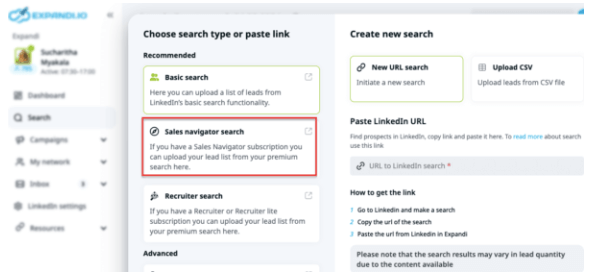8 Places for Sourcing Top Tech Talent [A Guide for Recruiters]

Recruiting top tech talent is no longer easy. With rapid technological advancements across job domains, the supply is falling short of the demand.
Additionally, many studies show that filling technical positions can take up to 50 days or more.
While most tech recruiters rely on job boards for skill-based hiring, tools like Expandi to scrape LinkedIn data aim to make the process quicker and safer.
In this article, we present eight of the best places for sourcing tech talent with actionable tips and examples.
8 best places for recruiting tech talent
1. LinkedIn Sales Navigator
Most recruiting professionals strongly believe that the LinkedIn Sales Navigator is better than LinkedIn Recruiting for candidate sourcing.
That’s because Sales Navigator is cheaper than Recruiter and has more filters (29) than its counterpart (21).
For example, you can add Sales Navigator filters like the following to fetch suitable candidates:
- Current and past company
- Years of experience
- School
- Current job title
- Years in current company
- And more!
Tutorial on finding and scraping top tech candidates from the LinkedIn Sales Navigator
These steps go over sourcing and scraping the right tech candidates using Sales Navigator and Expandi (for scraping):
Step 1: Go to the “Account” section on your LSN home page

Step 2: Expand “Technologies used” filter to enter and select the desired technologies you want to hire experienced folks for

Step 3: Add additional filters, such as Industry and Location, for a more accurate list, and save your results as a custom list

Step 4: From Account, go to the Lead section to find suitable candidates based on the previously created custom account list. Here, you can enter more candidate filters, such as Years in company, Past company, Current job title, and more.

Step 5: Save the search to use for scraping, or just copy the search URL and save it
Scraping the LinkedIn Sales Navigator search results using Expandi
Step 1: Sign up for the Expandi’s 7-day free trial
Step 2: Find the list of saved searches on your LSN account and copy the URL

Step 3: Now on your Expandi account, select Search and then Add new search

Step 4: Select the “Sales navigator search” from the list of search types

Select the “Confirm that it is active” button to tell Expandi that an LSN subscription has already been added to your LinkedIn account.
Step 5: Under “Paste LinkedIn URL,” enter the LSN search URL and click Next.

Step 6: Enter a search name and click Confirm.

Once confirmed, Expandi will start scraping the candidate results and display the results when done:

2. LinkedIn Events
As we speak, thousands of LinkedIn Events are scheduled to happen sometime in 2024. A LinkedIn Event has become a popular way for industry professionals to grow their network and connections.
Naturally, LinkedIn Events are also a safe haven for recruiters to hunt for suitable candidates for any open role.
Here’s how you can search a LinkedIn Event:
Say you’re looking to recruit for a Salesforce Senior Developer role. Run a LinkedIn basic search with “Salesforce” as the keyword and select “Events” filter:
As you can see, there are multiple events scheduled to happen which will most probably be attended by keen Salesforce enthusiasts who can be under your radar:

Next, select one or more events and join/sign up for them to access the attendees list. Once joined, copy the URL of the select LinkedIn event (ensure you’ve clicked on “Attend Event” before copying)

Now, we start scraping this list using Expandi.
Tutorial on scraping top tech candidates from LinkedIn Events
Step 1: Sign up for the Expandi 7-day free trial
Step 2: Go to Search and then select Add new search

Step 3: Scroll down the list of search types and select Event search.

Step 4: Paste the event URL and click Next

Step 5: Once done, enter a search name and click Confirm for Expandi to scrape the list of event attendees. Later, you can open the list to filter out relevant potential candidates who could be approached for the position.
Check out this article on setting up an Expandi Connector Campaign for automated outreach to the scraped members.
3. LinkedIn Groups
Like LinkedIn Events, Groups is another sure-shot way to source top tech candidates. There are multiple active LinkedIn groups across technology interests. It’s super easy to filter the best ones and join them to boil down a list of tech talent worth pursuing.
Suppose you want to source Java development candidates. Run a quick LinkedIn search with “Java development” as the keyword and select the “Groups” filter:
There are over 1700 search results:

Choose the best one and join it. Copy the search URL once you’ve joined the group for scraping in the next step.
Tutorial on scraping top tech candidates from LinkedIn Groups
Step 1: Sign up for the Expandi 7-day free trial
Step 2: Go to Search and then select Add new search

Step 3: Scroll down the list of search types and select Group search.

Step 4: Paste the copied group search URL from the previous section.

Click Next and then Confirm for Expandi to start scraping.
Check out this article on setting up an Expandi Connector Campaign for automated outreach to the scraped members.
4. Indeed
Indeed is one of the most sought-after job portals for recruiters and candidates alike. The platform has about 10 million unique visitors monthly and over 200 million resumes in its database.
So, Indeed should be on your radar for quickly sourcing tech talent.
But where do you begin?
Tutorial on sourcing and scraping top tech candidates from Indeed
For this short tutorial, we’ll be using Browse AI to scrape eligible Indeed candidates:
Step 1: Run a simple search for candidates’ CVs on Indeed for employers based on your technical requirements.

Run an advanced search by selecting more candidate filters, such as job title, years of experience, etc. Once done, copy the URL of the final output.
Step 2: Scrape candidate details using Browse AI as shown below:
- Create a free Browse AI account
- Select Extract Structured Data on your screen under the “Build New Robot” option

- Paste the Indeed search URL and select Start recording task. Install Chrome extension when prompted to start the scrape.

- Click on the “robot” and select the entire screen or a part of it you want to scrape.

- Name the list and review the captured results

Once you’ve reviewed the data, click Finish recording. You’ll be asked to name your robot to scrape the final results and download a CSV file.

5. AngelList (now Wellfound)
AngelList (now Wellfound) is one of the excellent resources for hunting worthy tech talent.
The platform connects startups with candidates and offers various job listings, company profiles, and search filters so you can find the best talent within the first few tries. It has over 10 million Startup-ready tech candidates, such as PMs, sales, marketing, and engineers, in the US and abroad.

6. GitHub
GitHub is a popular developer platform that allows developers worldwide who are skilled in various programming languages and technical skills to share and manage their code. With over 100 million users, GitHub is a goldmine for recruiters looking to source the best tech talent.
However, GitHub is not a recruitment or jobs platform, so it’s a more unconventional way of sourcing tech talent.
Recruiters and hiring managers can join the platform and scour through users uploading code in your target technology to evaluate their coding skills. Most users list their contact details like their email address and LinkedIn profile, making it easy for you to reach them for a one-on-one connection.

7. Stack Overflow
Stack Overflow is an international Q&A platform for developers to post questions and share programming knowledge.
Recruiters can leverage this platform to spot top technical professionals who answer questions using a specific programming language or technology. This means they’re highly skilled and worth pursuing for open roles.
For example, you can run a simple Stack Overflow Boolean search to find relevant questions from a specific technology and see who has answered them.

Under each question, you can find a top-rated user answering them and click on their profile to access further statistics:

You can use this data to assess their skills and tag them to start a discussion for potential collaboration.
8. Kaggle
Recruiting for a data science or machine learning-related position? Then, give Kaggle a try.
Kaggle is an online portal and community of the largest AI and ML learners and enthusiasts. It runs competitions and forums for learners to actively participate and get noticed, thus making the platform a recruiter haven.
Apart from this, Kaggle also has a job board where recruiters can post about open positions and allows participants to share their accomplishments and real-time data science/AI-ML skills.

Quick tip: Always measure your recruiting efforts to assess what’s working and what’s not. Track top KPIs to see where your recruiting campaign stands.
Wrapping up
If you ask us if there’s one platform that beats the rest in sourcing tech talent, then it should be LinkedIn.
With over a billion users worldwide, it stands out as THE platform to expand your reach, connect with true professionals, and select candidates who are the right fit for a specific role and your organization.
Start your LinkedIn recruiting journey with Expandi.
Scrape candidates and set up automated outreach campaigns to hire your dream employees with minimal effort.
You’ve made it all the way down here, take the final step


